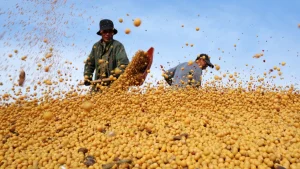Before Competing with the US, China Built the World’s Largest Granary
Agriculture is the foundation of the nation, and the development and stability of agriculture serve as the cornerstone of national prosperity.
From the early days of the nation, when everything needed rebuilding, to today’s thriving society, China’s agriculture has undergone tremendous changes. This article will comprehensively review and summarize the remarkable achievements China has made in agriculture, focusing on three aspects: strategic agricultural security, rural development, and the improvement of farmers’ livelihoods.
Strategic Agricultural Security
1) Technological Independence
China’s agricultural progress is inseparable from the support of science and technology. From the renowned hybrid rice of Yuan Longping, to achieving seed independence after the soybean and corn battle, to the ongoing public debates surrounding genetically modified (GM) technology, China has effectively secured autonomy in breeding technologies and agricultural industries.
Academician Yuan Longping, known as the “Father of Hybrid Rice,” not only solved the issue of feeding China’s population but also made tremendous contributions to global food security. The super rice varieties developed by Yuan’s team consistently set new yield records, providing a solid foundation for China’s self-sufficiency in grain production.

In 2003, international grain merchants launched a “soybean war” against China, highlighting the importance of seed security. Since then, China has made significant progress in breeding major crops such as wheat, corn, and soybeans, achieving independence in seed production, reducing foreign dependence, and enhancing the resilience of its agriculture.
GM technology has been a subject of controversy since it entered the public discourse. A decade ago, heated public debates temporarily halted China’s progress in advancing GM crop research. During this period, agricultural researchers had to use terms like “molecular breeding technology” to avoid the stigma associated with GM crops.
Today, public perception of GM technology has returned to a more rational standpoint. Seed banks and molecular breeding platforms at major agricultural research institutes are now operating in an orderly manner, laying the foundation for the commercialization of GM crops in the future.
In addition, China has made significant strides in agricultural mechanization, transitioning from simple tools to today’s smart agricultural machinery. Notably, China has full control over the related industrial chain, with domestically produced equipment such as combine harvesters, rice transplanters, and seeders being both high-performing and reasonably priced, earning widespread favor among farmers.
Moreover, China’s capacity for independent agricultural machinery research and development continues to grow, particularly with the integration of digital technology. Domestic agricultural drones and robots, suited to China’s diverse geographic environments, have already gained a leading international edge.

With the rapid development of information technology, smart agriculture has become a new direction for the technological autonomy of China’s agriculture. Through the use of the Internet of Things (IoT), big data, and cloud computing, precise management and efficient control of the entire agricultural production process have been realized.
For example, smart greenhouses, precision irrigation systems, intelligent pest monitoring, and integrated water and fertilizer systems not only enhance resource efficiency but also reduce environmental pollution. The development of smart agriculture offers new pathways for sustainable agricultural development.
2) Establishment of the National Reserve System
Whether it was the rice and cotton crisis in the early years of the People’s Republic or the soybean war in 2003, these events have consistently underscored the importance of establishing a national grain reserve system.
On May 18, 2000, China Grain Reserves Corporation (Sinograin) was officially founded, and in 2005, it became the main body responsible for implementing the minimum grain purchase price policy to protect farmers’ interests and stabilize the grain market.

During the 2005 wheat and corn battle, Sinograin made a bold declaration to international grain speculators: “China’s grain reserves stand at 100 million tons, enough to feed the entire population for a year. If you dare to speculate on food prices, think about whether you can handle this 100 million tons first.”
The national grain reserve system is a crucial component of a country’s agricultural strategic security. Establishing and refining this system helps a nation cope with the impacts of natural disasters and market fluctuations.
China’s grain reserve system dates back to the Sui and Tang dynasties, when a systematic grain storage structure existed (a three-tier system of central, local, and relief granaries). Today, however, China’s grain reserve system has a broader scope, and its storage capabilities are not limited to staple grains but also include more perishable items like meat.
In 2018, when pork prices in China soared to around 40 CNY per pound due to the African swine fever outbreak, the national grain reserve system stepped in by releasing large amounts of stored pork, which helped stabilize the prices.
Similarly, in times of natural disasters, the national grain reserve system plays a key role, highlighting its importance to national strategic security.
On May 12, 2008, a massive 8.0 magnitude earthquake struck Wenchuan County in Sichuan Province, causing significant loss of life and property. The earthquake destroyed homes and infrastructure and severely disrupted local agricultural production, leading to grain shortages.
In response, the National Food and Strategic Reserves Administration quickly activated an emergency plan, transporting central grain reserves to the disaster-stricken area. The reserves promptly supplied grain, oil, and fuel to the affected areas, ensuring that the basic living needs of the victims were met.
To prevent market chaos due to food shortages, the national grain reserve system increased grain supplies in surrounding areas, stabilizing market prices.
During the post-disaster reconstruction, the national grain reserve system continued to provide food support, helping the affected population return to normal life and production. It also supported agricultural recovery by providing seeds, fertilizers, and other production materials to ensure future grain supplies.
In early 2020, China faced the outbreak of the COVID-19 pandemic, which quickly spread across the country, affecting social, economic, and public life. Many regions imposed strict lockdowns, leading to disruptions in logistics and tight market supplies.
In response, the National Food and Strategic Reserves Administration promptly activated emergency plans, coordinating with regional grain reserve warehouses to ensure ample grain supply.
To prevent market panic and rising grain prices due to the pandemic, the national grain reserve system increased its market supply efforts, helping to stabilize prices.
In summary, the establishment of a national-level grain reserve system has significantly enhanced the country’s ability to respond to natural disasters and market fluctuations.
3) Land Reclamation
Since the founding of the People’s Republic of China, the country has undertaken large-scale land reclamation efforts, with the development of the Great Northern Wilderness (Beidahuang) and Xinjiang being particularly notable.
The Great Northern Wilderness was once a barren area, but through the tireless work of several generations, it has now become one of China’s most important grain-producing regions.
Similarly, the Xinjiang Production and Construction Corps transformed the desolate Gobi Desert into fertile farmland. In recent years, with the advancement of the Belt and Road Initiative, Xinjiang has once again become a hotspot for agricultural development. As a key starting point for constructing a new international order, this future granary will provide solid support for China’s globalization strategy.
4) Water Conservancy Projects
Water conservancy is the lifeblood of agricultural development. Since ancient times, great water projects like the Dujiangyan irrigation system have created fertile plains such as the Chengdu Plain.
Since the founding of New China, we have achieved remarkable success in water conservancy construction.
On a local level, we have built a series of irrigation canals to revitalize agricultural growth in various regions.
For example, the Hongqi Canal in Lin County, Henan Province, is one of the great engineering feats of the 1960s. Stretching 1,500 kilometers, it successfully diverted water from the Zhang River to Lin County, solving the region’s long-standing water shortage. It is known as the “man-made heavenly river.”

On a national level, to manage water resources across the country, we have constructed a network of water systems.
Among these, the South-to-North Water Diversion Project is a well-known and ongoing strategic endeavor. This project aims to address the uneven distribution of water resources in China, particularly the persistent water shortages in northern regions. By diverting water from the resource-abundant south to the north, the project meets the water needs of northern China.
The South-to-North Water Diversion Project is vast in scope, comprising three main routes: the eastern, central, and western lines. The eastern and central lines have been completed and are operational, while the western line is still in the planning phase.

The eastern route draws water from the lower Yangtze River in Jiangdu District, Yangzhou City, using a series of pumping stations and existing channels such as the Beijing-Hangzhou Grand Canal. Water is transferred northward through several lakes in Shandong Province and supplies parts of Tianjin and Shandong. This route spans approximately 1,467 kilometers and diverts about 9.6 billion cubic meters of water annually.
The central route draws water from the Danjiangkou Reservoir in the upper and middle reaches of the Han River. Through newly constructed channels and existing waterways, it supplies water to Beijing, Tianjin, and other areas in northern China. The central route is about 1,432 kilometers long and diverts about 9.5 billion cubic meters of water annually.
In addition, the Dianzhong Water Diversion Project in Yunnan aims to address long-standing water shortages in central Yunnan Province (known as “Dianzhong”).
In summary, water conservancy projects form the foundation of agricultural revitalization. The achievements of New China in this field are widely recognized and represent the most critical material basis for ensuring increased grain production.
Rural Revitalization
The countryside is the operational ground for agriculture and the source of grain production. Therefore, rural development is directly tied to the health and sustainability of agriculture.
After enduring the difficult years of an industrial-first national policy, China, having fully embarked on industrialization, adopted the Rural Revitalization Strategy as the guiding principle for modern rural development.
As a result, policies such as the abolition of agricultural taxes, infrastructure investment in rural areas, and industrial expansion into the countryside were implemented, turning rural development into a crucial component for stabilizing the nation in the face of global challenges. Rural areas were connected with roads, electricity, water, gas, and the internet. Their appearance underwent a complete transformation, with many modernized villages springing up like mushrooms after a rain.

The improvement of rural infrastructure has not only enhanced transportation, communication, and electricity access but has also provided strong support for rural economic development. The diversification of rural industries—especially the rise of ecological agriculture and rural tourism—has opened up new avenues for increasing farmers’ incomes.
The structure of China’s rural economy has evolved from collective farming under cooperatives, to the household responsibility system, and now to a hybrid model. The industrial landscape has shifted from being closed and singular to open and diversified.
From the township and village enterprises of the past to the burgeoning ecological industries of today, rural areas are no longer merely agricultural production units. Instead, they are becoming multifaceted spaces that integrate landscape, agriculture, and nature. This new industrial logic has given rural areas a unique ecological niche compared to urban environments, offering a sustainable path forward for rural development in China.
Improvement in Farmers’ Quality of Life
Farmers are the driving force behind agriculture and the very soul of rural areas. As the saying goes, a civilization without people is meaningless.
The improvement in farmers’ quality of life in the People’s Republic of China stands as one of the country’s greatest achievements, unmatched globally.
At the beginning of the country’s founding, the land reform movement granted farmers ownership of their land, liberating them from the exploitation of landlords in the old era. This initial reform improved their basic living conditions and alleviated hunger. Additionally, rural literacy campaigns were launched, gradually raising the cultural level of the rural population.
In 1958, the People’s Communes were widely established across the country, operating under the “one big and two public” system. Despite the domestic and international challenges of the time, these communes effectively organized rural grassroots communities, maintaining social stability and fostering collective rural economies, laying the cultural foundation for later forms of “new collective economies” in rural China.
Though material resources were scarce during that period, spiritual life was relatively rich. The People’s Communes organized farmers to complete much-needed national infrastructure projects at a relatively low social cost during the early years of the Republic.
In the early stages of China’s reform and opening up, the Household Responsibility System was introduced to unleash economic productivity. This gave farmers greater autonomy over their agricultural output, significantly boosting their incomes and elevating their standard of living.
Moreover, the restoration of the national college entrance examination (Gaokao) provided rural residents with opportunities for upward mobility through education. My own father, for example, was the only person in his village to be admitted to university, a chance that opened up a broader life path for him.
As urbanization accelerated, township and village enterprises thrived, reshaping the industrial landscape of rural areas. These developments led to economic success stories like “Huaxi Village,” which became emblematic of rural prosperity. Additionally, many rural youth found employment opportunities in urban areas, spurred by the cityward migration trend.
This allowed for flexible survival strategies: when there was less work to be done on the farm, rural laborers could take factory jobs. This provided them with more flexible livelihoods.
The rise of new rural industries also offered farmers opportunities to earn higher incomes without leaving their hometowns. For instance, the “Huanglongxi Happy Farm” project in Shuangliu District, Chengdu, created many local jobs, increasing the villagers’ monthly income by an average of 3,000 yuan. Some core positions even provided villagers with agricultural management roles and technical guidance, allowing them to earn more than 10,000 yuan a month.

With farmers’ incomes rising, their consumption levels also significantly improved, and their spending patterns shifted from meeting basic needs to addressing higher-level desires.
The state heavily invested in rural infrastructure, providing universal access to utilities such as roads, electricity, water, gas, and internet. The benefits of information technology have trickled down to rural areas, and cost-effective, efficient logistics and delivery systems now reach even remote villages, making life for farmers more convenient.
As someone born in the 1980s who spent several months each year during school vacations in rural areas, I have witnessed these changes firsthand. When I was a child, my grandmother’s house was heated by coal briquettes, meals were cooked over a wood fire, and kerosene lamps lit the home. We children entertained ourselves with mud and insects. But in 2010, I returned home to find my nephew playing an online racing game, and I was completely stunned.
Last year, I visited again and found that the local new village had gained a reputation for its stunning beauty. The village had even built a children’s amusement park that rivaled those in big cities. What struck me most was that the annual pass for locals was less than 100 yuan—a price unimaginable in urban areas. One of my friends from Chengdu, who brought her child home for a visit, even joked about wanting to become a villager.
Furthermore, the elimination of agricultural taxes and the increase in agricultural subsidies have greatly boosted farmers’ per capita disposable income, which has grown by 331.2 times compared to 1949 and by 108.4 times compared to 1978.
China’s rural social security system has also been steadily improving, with the new rural cooperative medical care system and rural minimum living guarantee system expanding their coverage.
Although there is still much room for improvement in the overall sense of well-being among rural residents, and although there are micro-level disparities when comparing China’s rural population to those in developed Western countries, it is important to recognize the impressive progress that has been made. Considering China’s late start in modernization, its massive population, its diverse geography—which presents uneven development challenges and costs—and the fact that it has not benefited from colonial wealth accumulation to fund social programs, the continuous improvement in the living conditions of China’s farmers is a remarkable achievement. Even if we refrain from boasting out of humility, we should not be overly critical of ourselves.
Conclusion
China’s greatness does not lie in being flawless or leading the world in every aspect. Rather, it stems from its self-reliance, its relentless pursuit of strength, and its ability to forge a unique path of modernization and globalization—one that does not harm others but continuously pushes itself forward.
This is a monumental practice that challenges the hegemonic path of colonial plunder, a path that “robs the weak to benefit the strong.” It is also a profound embodiment of the “kingly way,” which “takes from the strong to support the weak.” It is this spirit that forms the foundation of China’s ability to break through the unprecedented global transformations of the last five centuries.
China’s agricultural development is a microcosm of the nation’s broader progress. By reflecting on the development of agriculture, we are also revisiting the heart and soul of this great republic’s journey!
Editor: Zhaocheng_Pan
https://www.guancha.cn/norlanseed/2024_10_07_750883.shtml



